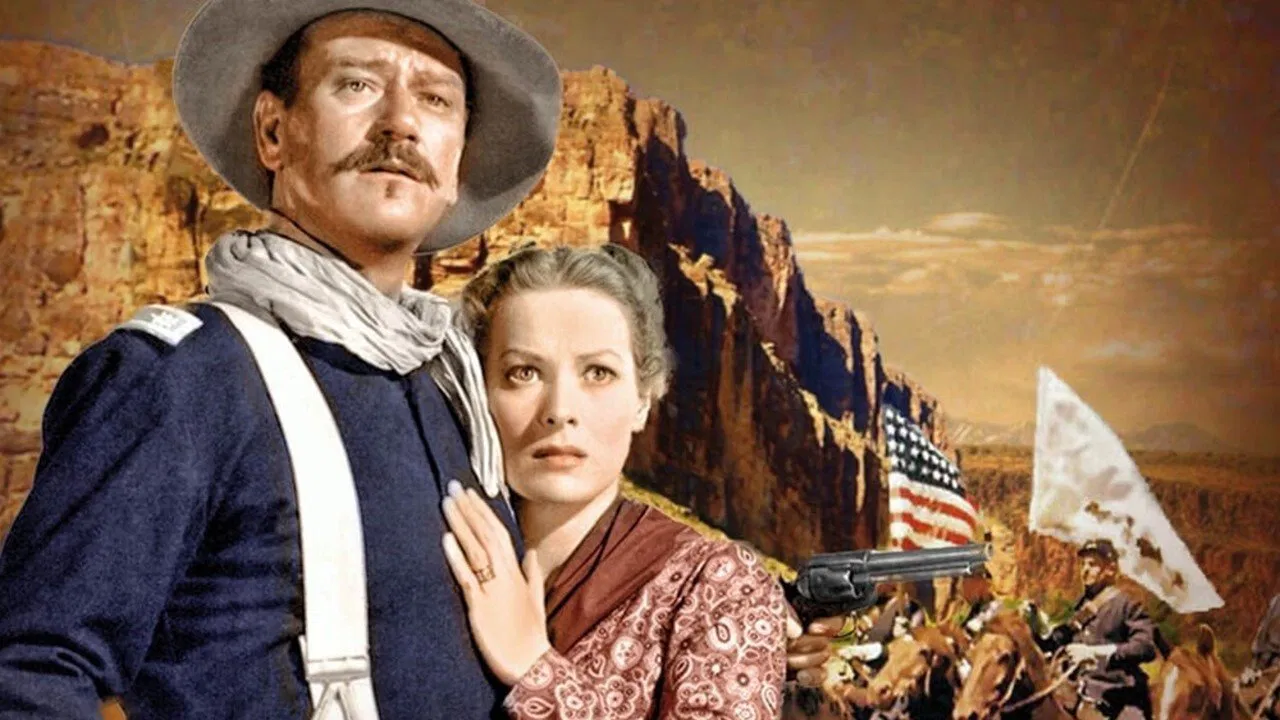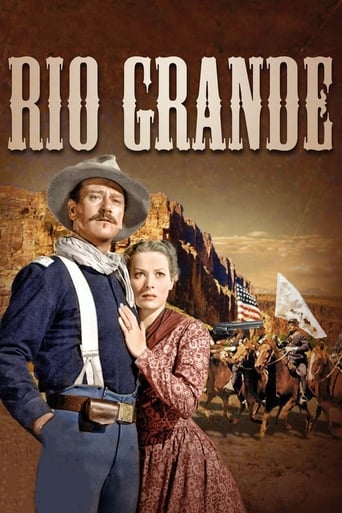

Just so...so bad
... View MoreBeautiful, moving film.
... View MoreClever and entertaining enough to recommend even to members of the 1%
... View MoreBlistering performances.
... View MoreThis "RIO GRANDE" is a long forgotten western of the legendary director John Ford that surprises pleasantly. Irish songs and a very good level of romance make this movie a beautiful western, which has a great humor also present (the character Quincannon, played by actor Victor McLaglen, gives the film extremely funny scenes). This is a very effective western, although of a substantially different style to others of the Ford / Wayne duo (for example, the first time the character Yorke, starring John Wayne, picks up a gun happens only 6 minutes from the end of the movie !). The good virtues of the film make to forget its (enough) small faults, that end up not having great importance in the development of the plot. Perhaps the only one that is more noteworthy is the (sadly) little participation and importance given to the character Kathleen, played by the extremely beautiful Maureen O'Hara (here in the first of five "romantic" partnerships she would do with John Wayne). On the other hand, one of the very positive aspects of the film is the importance and excellent performances of the secondary actors, such as Ben Johnson, Claude Jarman Jr, Harry Carey Jr and the aforementioned Victor McLaglen. In short, this "RIO GRANDE" is a beautiful surprise.
... View MoreThe last of director Ford's cavalry trilogy, all starring or costarring John Wayne, and including Victor McLaglen as the cut up sergeant major, usually leading the comic relief, balancing Wayne's serious roles. Also, all involved hostile or potentially hostile Native Americans(N.A.)of the southern plains or Southwest. In this film, as well as the previous "Fort Apache", the Apache were the featured threatening N.A., whereas in "She Wore a Yellow Ribbon", it was a confederation of other southern plains tribes. Wayne's character, who had been given a different name in the latter film, regains his name: Kirby York(modified to Yorke)from "Fort Apache" , suggesting that the present film might be considered a sequel to that film, in which Yorke pays back the Apache for their thrashing of the cavalry in the earlier film....I suspect this was Ford's last B&W film, he generally favoring B&W over color through his long previous career. "She Wore a Yellow Ribbon" was filmed in Technicolor, finally giving his audiences a colorful view of some of his favorite scenic landscapes in the Southwest.Ford's agreement with Republic Pictures was that they would finance this cheapie, which hopefully would turn a fair profit, in exchange for financing Ford's long denied pet project, which would become known as "The Quiet Man": to be filmed in Technicolor and on location in Ireland, as Ford demanded. Republic wrongly predicted a loss on that film. Republic also stipulated that Wayne and popular Maureen O'Hara, along with Victor McLaglen, would star in both films. Thus, instead of a 'young love' aspect to the script, as in the 2 previous films, Maureen(as Kathleen) was cast as the estranged wife of Colonel Kirby, whose marriage had been blown apart by the Civil War, which pitted Yankee officer Kirby against her Shenandoah family, he and Stg. Quincannon(McLaglen) having been ordered by General Sheridan to torch the family plantation. She has traveled far to this western outpost to retrieve her son Jeff who, by chance, was recently assigned to his father's outfit as a new recruit, and refuses to leave nor to use his family status as a springboard for special treatment.The foray of the cavalry across the Rio Grande, into Mexico, is based upon a historical incident, in which renowned 'Indian' fighter Ranald McKenzie was diverted by his commander Phil Sheridan from his campaign against the Comanche to destroy the villages of marauding N.A.s using Mexico as a sanctuary. The film accurately portrays Sheridan as giving this as an unofficial order, to avoid an international incident if it turned out badly. Actually, the N.A.s were mostly Kickapoo, with some Lipan and Mescalero Apache and other tribes represented. Interestingly, the stampeding of the horses of the threatening confederation of southern plains tribes in "She Wore a Yellow Ribbon" can be considered a loose representation of McKenzie's final victory over the remaining renegade Comanche and allies, with minimal loss of life on both sides. It's apparent that the new recruits(only 18 instead of the 180 promised) tend to form friendship groups based on their former identities as Union or Confederate soldiers or sympathizers. Thus, Kirbe's son Jeff(a Virginian, played by Claude Jarman) soon forms a friendship group with Texans 'Sandy'(Harry Carey, Jr.) and Travis Tyree(Ben Johnson). Carey and Johnson had fairly high profile roles in "She wore a Yellow Ribbon" and were a buddy pair in Ford's other western released in '50; "Wagon Master", as they are in this film. Carey was nicknamed 'Sandy' in both '50 films. Johnson was Travis in both '50 films, but retained his last name from "She wore a Yellow Ribbon" as did McLaglen. Those who have seen "The Yearling" will easily recognize Claude(Jeff) as Jody. Chill Wills, also in that film, plays the fort doctor here.Like "Wagon Master" and unlike the 2 previous cavalry westerns, this film was shot in Eastern Utah, without significant additional use of Monument Valley backdrops. Presumably, the Colorado River substituted for the Rio Grande.Although the previous films of the trilogy included occasional songs sung by the cavalry or featured at social gatherings, music supplied by the Sons of the Pioneers, included among the troopers, positively permeates this film, and often relates to the hoped for rekindled relationship between Kirby and Kathleen. It begins appropriately with "I'll Take You home , Kathleen", initially heard from a music box she brought, soon elaborated on by troopers as she dines with Kirby. During the finale, to Kirby's surprise, the parading troopers sing "Dixie". Maureen guiltily smiles, and General Sheridan nods his approval, as most of the troopers being honored for their part in shooting up the Apaches and rescuing the stolen children are southerners.In a running gag, Travis is periodically nearly taken away by a marshal on a murder charge, but is deemed too valuable a trooper to lose, and always escapes, with or without Kirby's approval.I don't understand why they had the raiding Apaches living around a Mexican mission rather than in a typical Apache village, nor why the Apaches attacked the poorly constructed fort in broad daylight(risk of high mortality). Historically, there was a reservation Seminole village(not the presumed Apaches shown)close to Fort Clark, which supplied scouts for the raid across the Rio Grande from this fort.
... View MoreSupposedly John Ford agreed to make this film in exchange for the go ahead on "The Quiet Man" that followed, also starring John Wayne, Maureen O'Hara and Victor McLaglen. For my money, Ford was right--"The Quiet Man" is the better film, by far.But "Rio Grande" is not a bad film. It is somewhat formulaic--like many of its type. The usual formula is: *Establishment of story within a western fort that house cavalry, surrounded by savage Indians. The fort is run by a strict officer and includes an Irish Sergeant. *A woman is introduced to the story, with subsequent romantic involvement. *Action scenes involving conflict with the Indians, preferably set in the environs of stark and beautiful terrain that is now a national park."Rio Grande" has all that. It also includes enough music that this film might be classified as a musical. The fort, luckily, has its "regimental singers" and a military band that could rival a philharmonic.Colonel Kirby Yorke's (John Wayne) son is played by Claude Jarman, Jr., only four years removed from his emotional, rookie role in "The Yearling". He holds his own and even performs his own horse riding stunts.One thing this film has going for it is horsemanship. Tragically, two stuntmen drowned while filming a river crossing, but the riding in this film is second to none.The acting, in general, is good. Wayne seems in his prime and O'Hara shines, though the film is in B&W.But "Rio Grande" is burdened by a script that is sometimes disjointed, that treats Indians as little more than evil nuisances (as most westerns do), and includes a number of anachronisms.Watch "Rio Grande" for its sentimental ballads and lusty folk songs, its majestic cloud formations, and one interesting plot twist regarding why the two lovers split some fifteen years before.This movie is a mixed bag, so I can only rate it 6/10.
... View MoreThis is a great John Wayne movie. The hard bitten colonel commanding the Union cavalry force that is out to corral the Apache raiders is portrayed very well by Wayne. His estranged wife, Maureen O'Hara, shows up when their son, who flunked out of West Point, appears as a new recruit in his father's command. The two were on opposite sides during the Civil War and their irreconcilable difference was the fact that Wayne's troops burned her plantation during the war. Victor McLaglin plays his usual hard drinking, sergeant to the hilt, his accent is a great plus as a lot of the army after the Civil War ended were made up of Irish and German immigrants. A lot of whom had service experience in their former countries. The scene where a trooper gets killed and turns out to be a former Confederate general, which Wayne knew about, and Wayne allows the burial to be performed by the ex rebel troopers that served under him is kind of touching.
... View More